Mad Hedge Biotech & Healthcare Letter
September 9, 2021
Fiat Lux
FEATURED TRADE:
(A STOCK FOR BARGAIN HUNTERS)
(SRPT), (MRNA), (BNTX), (FGEN), (ACAD), (RARE), (BLUE), (CRSP), (PFE)

Mad Hedge Biotech & Healthcare Letter
September 9, 2021
Fiat Lux
FEATURED TRADE:
(A STOCK FOR BARGAIN HUNTERS)
(SRPT), (MRNA), (BNTX), (FGEN), (ACAD), (RARE), (BLUE), (CRSP), (PFE)

Biotechnology stocks that have fallen by over half since 2021 started are strewn around in the market.
While the share prices of COVID-19 stocks, such as Moderna (MRNA) and BioNTech (BNTX), have skyrocketed, the others in the sector are not as fortunate.
The biotechnology segment has been filled with relative horror stories from previous favorites like FibroGen (FGEN), Acadia Pharmaceuticals (ACAD), and Ultragenyx Pharmaceutical (RARE).
Among the companies hit with disappointing news, the gene therapy sector, which has stocks like bluebird bio (BLUE) and CRISPR Therapeutics (CRSP), appears to be having a tougher time than most.
So, where does this situation leave investors? Where should we look for value?
One tactic that would help value investors take advantage of this abysmal situation is studying Wall Street analysts' moves.
Look at target prices they set for the stocks they cover and then choose the companies trading the farthest below the expected price points.
Among the biotechnology stocks struggling these days, one of the names that emerged as a truly promising investment is Sarepta Therapeutics (SRPT).
To say that Sarepta has been experiencing a disappointing year is an understatement. Shares of this company have gone on a 57% heart-stopping plunge since 2021 started.
In fact, this biotech’s nosedive is the third-worst in the midcap or larger stock sector based on the two key exchange-traded funds: iShares Biotechnology ETF (IBB) and SPDR S&P Biotech ETF (XBI).
Despite Sarepta’s abysmal performance, Wall Street still labels the stock a buy.
Sarepta’s decline started in early January when the trial results for its gene therapy for Duchenne muscular dystrophy (DMD) failed to impress investors.
However, the subsequent trial for the same gene therapy, dubbed as SRP-9001, is anticipated to yield better results.
Although the results are expected to be released by late 2022 or early 2023, holding the stock for now is estimated to deliver remarkable profits for patient investors.
At this point, Sarepta stock is trading at roughly $80 per share.
However, experts predict that the next results for SRP-9001 would push the shares to climb to over $200.
DMD, which is a rare degenerative condition characterized by gradual weakening of the muscles, affects about 16,840 people in the US.
So far, the US FDA has only approved a handful of treatments for DMD—three of which are RNA-based drugs developed by Sarepta.
Evidently, the company has a firm grasp of the condition and a proven track record of launching and marketing DMD-centered products.
More importantly, this makes Sarepta a dominant—if not the most dominant—force in the DMD market.
What makes their newest treatment, SRP-9001, different is that it works on DNA. Despite the extended timeline, Sarepta’s candidate remains the frontrunner in this endeavor.
Its closest threat is PF-06939926, an investigational drug from Pfizer (PFE) that uses the same technology as SRP-9001.
At the very least, this competitor is two years away from producing any tangible result.
By the time Pfizer reaches Phase 3, Sarepta’s SRP-9001 has already generated roughly $1 billion in sales.
Apart from the three approved drugs, Sarepta still has 34 drug development programs focused on two niches: RNA and AVV gene therapies. Among them, 7 are already in the clinical stage, including SRP-9001.
If successful, the company will reach $1 billion in revenues by 2023.
Another reason that makes Sarepta an attractive opportunity is its notably intact cash flow backbone—an achievement that’s worth pointing out considering its underwhelming SRP-9001 results.
The company also has an impressive history.
Sarepta has blossomed from its humble beginnings working as a contractor for the Department of Defense on the Ebola virus. Since then, it has developed its pipeline through acquisitions and launching effective treatments for rare diseases.
While Sarepta’s treatments are effective, they cannot cure DMD. They can only slow its progression.
This means continuous and life-long use among patients. For context, one treatment costs an average of $300,000 per patient annually.
Although it lost over 50% of its value, Sarepta still has enough capacity to rebound soon.
The factors that would help the company achieve this include the strong lineup of products generating solid and predictable revenues as well as its promising pipeline.
More importantly, its struggles with SRP-9001 don’t seem enough for the company to scrap the project altogether.
If anything, it proved that Sarepta can explore more potent treatments for DMD by looking into RNA technology—a path that the likes of Moderna and BioNTech have already found success in.
Overall, I think Sarepta still has a lot left in the tank. It operates in one of the most exciting sectors.
It’s worth bearing in mind that the biotech sector is ripe with innovation from companies with the ability to conjure up life-changing treatments—a value perceived as a crucial hallmark for massive gains.
Needless to say, Sarepta’s achievements in the DMD sector and its growth trajectory make it a shoo-in in this category.
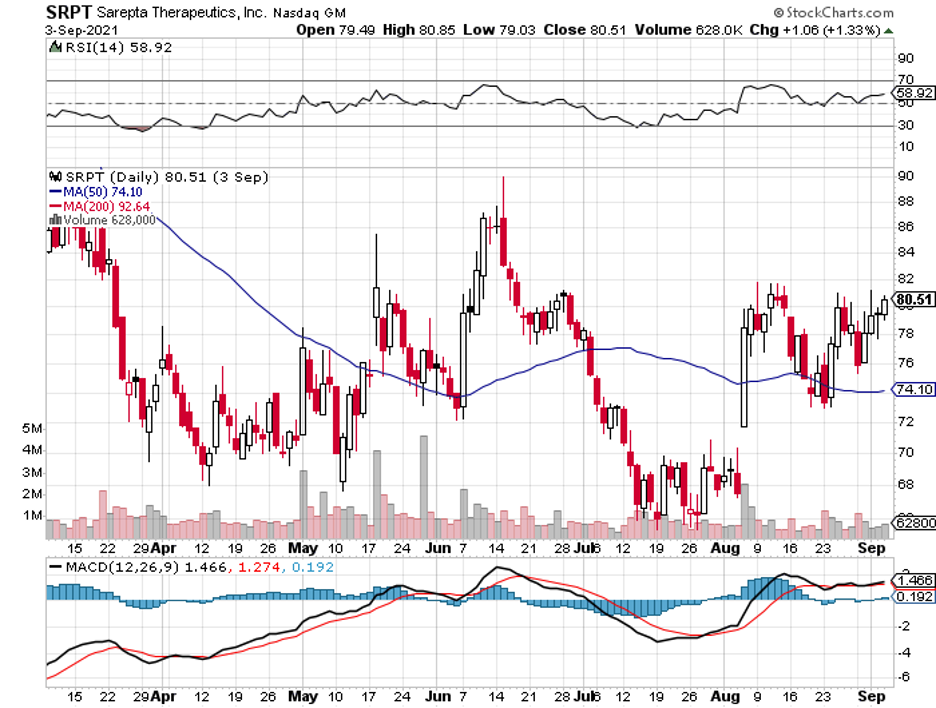
Mad Hedge Biotech & Healthcare Letter
August 24, 2021
Fiat Lux
FEATURED TRADE:
A GENE EDITING PURE PLAY UP FOR GRABS
(MRNA), (EDIT), (CRSP), (NTLA), (VRTX), (REGN), (BMY),
(BLUE), (NVO), (GRTS), (INBX), (BEAM), (VERV), (SGMO)

Moderna (MRNA) is faced with a dilemma. And it’s a pretty good problem to face at this point.
The biotechnology company has a flourishing cash stockpile courtesy of the increasing demand for its COVID-19 vaccine, and it needs to find something to do with its overflowing cash.
As of the end of the second quarter, the company has already reported a cash position of over $12 billion—a figure that offers Moderna the flexibility to go on a bit of a shopping spree.
So far, Moderna has set its sights on expanding its internal R&D programs on top of the $1 billion share repurchase program approved by its board of directors.
However, the most exciting news is the company’s plans to potentially make acquisitions soon.
This is where Editas Medicine (EDIT) enters the picture.
Moderna has not been shy in declaring that it wants to add gene editing therapies to its growing pipeline along with nucleic acid technologies and mRNA.
While Moderna did not specifically mention Editas in its plans, the smaller biotechnology company looks to be the most promising candidate for acquisition, especially if the COVID-19 vaccine leader plans to jump right into the action in the gene editing space.
After all, there are only three companies in this segment with therapies under clinical testing: CRISPR Therapeutics (CRSP), Intellia Therapeutics (NTLA), and Editas.
CRISPR Therapeutics is practically joined at the hip with Vertex Pharmaceuticals (VRTX). Meanwhile, Intellia has a strong ongoing partnership with Regeneron (REGN).
That leaves Editas, which currently has no partner for its lead program, making it a prime buyout candidate for Moderna.
Editas is also the cheapest by far among all three clinical-stage biotech with $4.12 billion in market capitalization.
In comparison, CRISPR Therapeutics has a market cap of $8.93 billion, while Intellia has a market cap of $10.97 billion.
Moderna could find Editas’ lower market capitalization as an add-on, as it would allow the bigger biotech to not spend all its cash on the acquisition.
Moreover, Editas has another advantage.
While both CRISPR Therapeutics and Intellia only focus on CRISPR-Cas9, which is a way to locate and bind targeted genes, Editas has developed another option platform to do that.
Its alternative option, called Cas12, could boost the company’s capacity to develop gene editing treatments.
Simply put, its rivals only have one weapon in their arsenal, while Editas has come up with a dual-option CRISPR platform to double its chances of succeeding in gene therapy development.
If, for instance, Moderna does not acquire Editas, there are still a lot of options available for the bigger company.
One possibility is with Juno Therapeutics, which is part of Bristol-Myers Squibb (BMY), as the company is already collaborating with Editas on the development of genetically modified T-cells to come up with a powerful cancer therapy.
Meanwhile, if Editas’ pipeline and portfolio do not quite cut it with Moderna, another potential buyout candidate for this biotechnology giant is bluebird bio (BLUE).
While it’s not as advanced as CRISPR Therapeutics, Intellia, and Editas, bluebird bio has ongoing work with the likes of Bristol-Myers Squibb, Regeneron, Novo Nordisk (NVO), Gritstone Oncology (GRTS), and Inhibrx (INBX).
Other candidates that Moderna could take into consideration include Beam Therapeutics (BEAM), Verve Therapeutics (VERV), and Sangamo Therapeutics (SGMO).
Regardless of Moderna’s future decisions, its announcements that it plans to expand on the gene editing space could potentially spur other huge biopharmaceutical companies to explore their own business development agreements with up-and-coming biotechnology firms.
In fact, even if Moderna ends up not calling, there’s a big possibility that Editas could easily find others who will be interested in acquiring this pure play gene editing frontrunner.
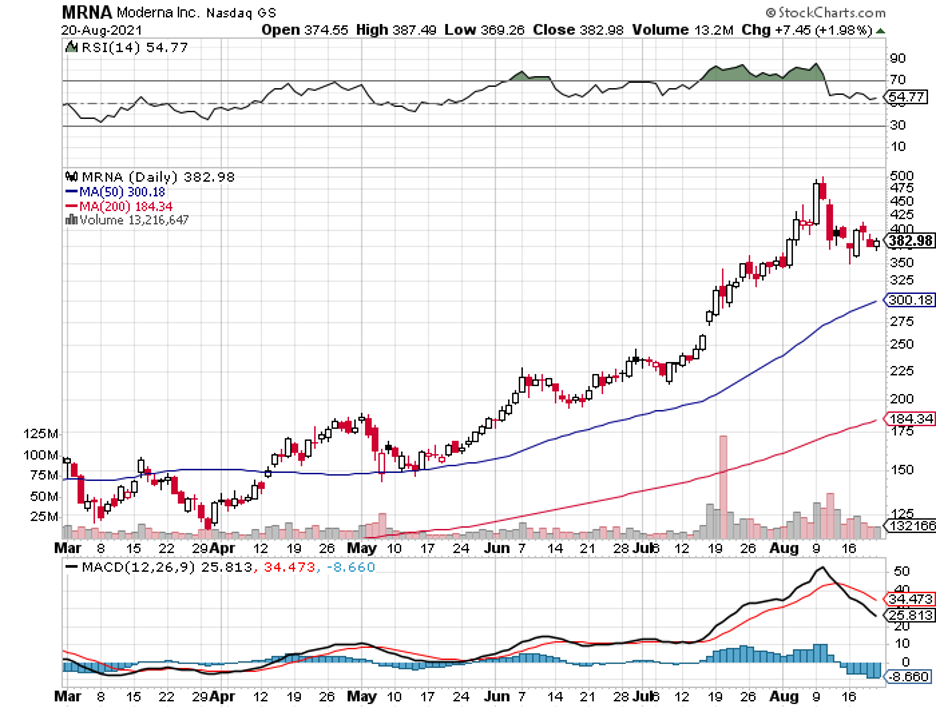
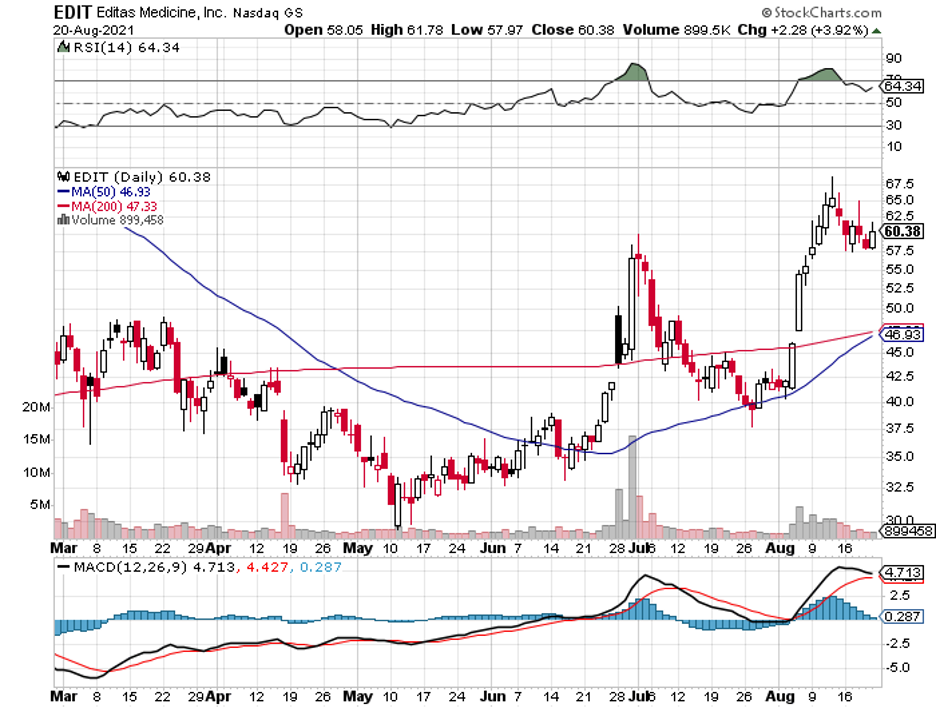
Mad Hedge Biotech & Healthcare Letter
August 19, 2021
Fiat Lux
FEATURED TRADE:
A LOW-PROFILE BIOTECH WINNER
(VRTX), (ACAD), (SRPT), (FGEN), (MRK), (MRNA), (NVS), (XLRN), (PTGX), (IONS), (BLUE), (EDIT), (ABBV)

Choosing winners among biotechnology and healthcare stocks these days isn’t easy.
Since the year started, the sector has been marred with several unexpected disappointments like the 50% decline of crowd favorites Acadia Pharmaceuticals (ACAD) and Sarepta Therapeutics as well as the 33% fall of the ever-dependable FibroGen (FGEN).
So, how can investors pick a winner?
One tactic is taking a peek at what Wall Street analysts are doing, noting which among the companies they’re following are trading the farthest below the estimated price points.
Among the names on the list, a particular stock stands out as a strong contender these days: Vertex Pharmaceuticals (VRTX).
Although it’s one of the most widely known biotechnology companies today, Vertex actually started in a garage of a Harvard-trained chemist, Joshua Bogner, who left his cushy job at one of the most illustrious big pharma companies at that time, Merck (MRK), to pursue his vision.
The company’s raison d’être was a major selling point for a lot of talented and idealistic scientists in that era.
That is, Vertex wanted to find cures for the most challenging diseases and do this in an unbureaucratic setting.
Since then, Vertex’s goal has been straightforward: tackle the most complex and toughest diseases and deliver breakthrough treatments that offer tangible benefits to patients.
Over the years, the company has managed to keep this goal at the forefront of its efforts, starting with its work on the devastating genetic disorder called cystic fibrosis (CF).
Vertex’s work on CF took over a decade, but it eventually led to an impressive franchise that helped with the treatment of patients.
In the first quarter of 2021 alone, sales in this segment reached $1.7 billion.
Expanding on its work, Vertex has explored genetic therapies and set up a collaboration with Moderna (MRNA) in 2016.
Using the latter’s well-established expertise in messenger RNA technology, the companies are expected to come up with more aggressive and advanced CF treatments in the coming years.
Given these developments, Vertex reiterated its 2021 sales guidance to be somewhere in the range of $6.7 and $6.9 billion. Meanwhile, sales of its CF franchise are estimated to peak at $9 to $10 billion—if not higher—by 2024.
Aside from its work on CF, Vertex has also been pouring resources on developing treatments for severe sickle cell anemia and beta thalassemia, a rare blood disorder.
In fact, the company has been looking into these developments as the next major revenue stream, as seen in its bolstered collaboration deal with CRISPR Therapeutics (CRSP).
In this deal, Vertex paid the smaller biotechnology company $900 million upfront plus a potential addition of $200 million following the first regulatory approval of their therapy, CTX001.
While this may sound like a hefty deal to some, Vertex actually values CTX001 at roughly $11 billion.
CTX001, which is a one-time therapy, is priced at roughly $1 million per patient. At this point, the market for beta thalassemia is valued at $32 billion.
Needless to say, this would make CTX001 a massive income generator in the next few years.
Considering the lucrative market for beta thalassemia, though, it’s no surprise that several competitors have emerged to grab their share as well.
Some companies, such as Novartis (NVS) and Acceleron (XLRN), offer maintenance drugs for the disease.
Meanwhile, others like Protagonist Therapeutics (PTGX) and Ionis Pharmaceuticals (IONS) are attempting to develop treatments that would become direct competitors of CTX001.
However, the closest rivals of the Vertex-CRISPR candidate are from Bluebird Bio (BLUE) and Editas Medicine (EDIT).
While this has become a crowded space, Vertex and CRISPR remain the leaders in this segment, as most of the other candidates are still in the investigation phase.
Since it was founded in the 1980s, Vertex has remained true to its vision of tackling some of the toughest diseases out there.
While big pharmaceutical companies, such as AbbVie (ABBV), decided to expand their portfolio through acquisitions, Vertex leveraged its talent pool and maximized its funds by establishing strategic collaborations instead.
This tactic provided the company with enough elbow room that eventually led to its dominance in the CF space, where it now enjoys a virtual monopoly until at least the next decade.
Meanwhile, it has forged strong relationships with promising biotechnology companies and can very well be on its way to becoming the most dominant force in the rare blood disorder segment.
Overall, Vertex Pharmaceuticals is an attractive stock with an impressive portfolio and an even more impressive pipeline.
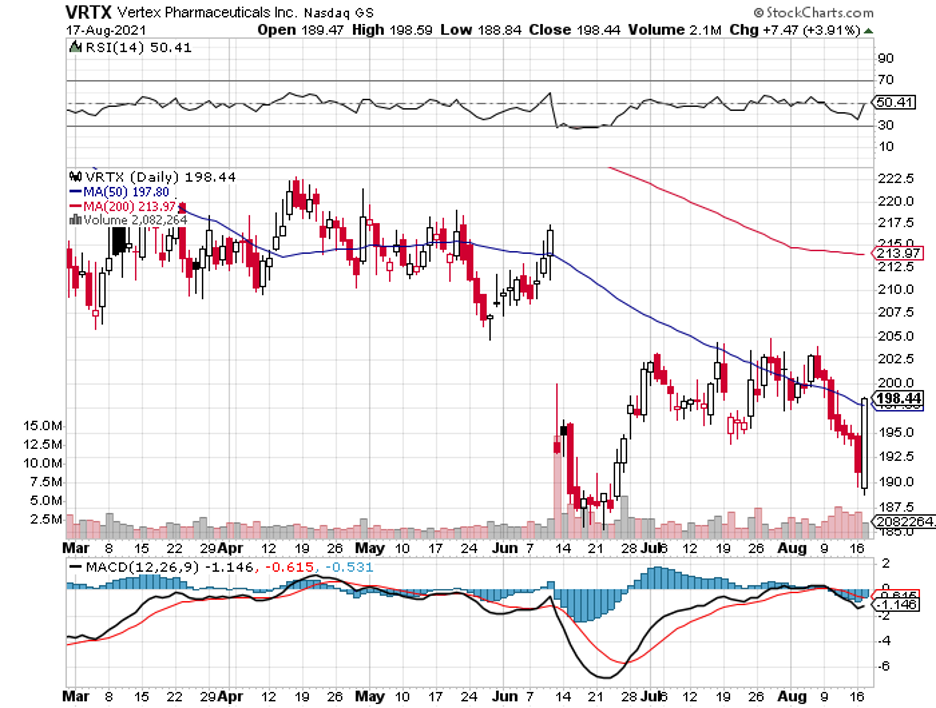
Mad Hedge Biotech & Healthcare Letter
August 12, 2021
Fiat Lux
FEATURED TRADE:
(THE FUTURE OF REGENERATIVE MEDICINE)
(CRSP), (EDIT), (BLUE), (PFE), (AZN), (GSK), (TAK), (REGN)

As our bodies begin to show signs of aging and fatigue, exploring ways to regenerate our organs has become crucial in ensuring a hale and hearty lifespan.
This demand has given rise to a branch of biotechnology and healthcare, which could very well be on the brink of becoming the next big thing in the mainstream biopharmaceutical industry: regenerative medicine.
For example, experts at Gladstone Institutes is applying gene therapy to repair heart damage. Basically, their goal is to reprogram scar tissue and transform it into a new heart cell.
What they do is inject the genes into the damaged heart caused by a heart attack. Then, these “new” genes alter the scar cells, converting them into beating hearts.
This approach no longer demands any cloning to obtain an extra set of organs. The Gladstone Institutes’ use of gene therapy allows us to regrow our own set of organs right inside our bodies.
And in case you’re wondering whether this type of work actually has a future or just another trend that would quietly disappear in the future, I’m telling you that this industry has incredibly potential.
Just look at the $12 billion valuation of a biotechnology unicorn called Samumed in San Diego.
Founded in 2008, this company has spent most of its lifetime operating under the radar. It impressively came out of the shadows last 2016 and was quickly dubbed as an “anti-aging” company.
To them, though, they’re a “de-aging” company. That is, they believe that people should be brought back to their peak health conditions before they can even begin to restore youth.
This ideology is exhibited by the company’s lead program: a knee osteoarthritis cure called Lorecivivint.
As we know, osteoarthritis has no known treatment that works to reverse the damage to the joint.
That’s why the doctors focus on handling or managing the symptoms. They tell their patients to exercise and lose weight to boost muscle strength and decrease the burden on their joints.
They also prescribe various drugs like painkillers, some anti-inflammatory pills, and even cortisone shots. Other patients would eventually need to go through replacement surgery.
This is where Samumed comes in.
The company created Lorecivivint to repair the joint damage. That way, patients will no longer need to go through all the burden of managing the symptoms of knee osteoarthritis.
In their proof-of-concept report, Samumed shared that one year after getting injected with Lorecivivint, the X-rays of the knees of the patients showed that there was an increase in “medial compartment joint space width.”
In simpler terms, the knees grew cartilage after a single shot of Lorecivivint.
Other than working on a cure for knee osteoarthritis, Samumed is also looking into treating male pattern baldness.
Another impressive biotechnology company focused on regenerative medicine is Humacyte, which recently shifted from being a clinical-stage firm to a commercial one.
Humacyte’s core work is on Human Acellular Vessels (HAVs) or “implantable regenerative human tissue.”
A use case for this is when a patient has damaged blood vessels. Typically, there are three options to treat this: take a vessel from another part of the body, try to implant a donated vessel, or utilize a plastic tube.
The first one requires at least two surgeries and, of course, losing a vessel in another part of your body.
Meanwhile, the second and third options expose the patient to the possibility of an infection or the body rejecting the vessel or plastic tube.
Humacyte’s HAVs offer a fourth option.
Since the HAVs carry similar properties as the native tissues of the patient’s body, they significantly lower the risk of rejection.
Basically, they’re “growing” HAVs that won’t be rejected by the body.
More importantly, the company is creating engineered off-the-shelf replacement tissue that can be implanted to anyone without using immunosuppressive drugs.
This is impressive because immunosuppressants are staples in ensuring that the body does not reject the organs. However, the use of this can be dangerous because it increases the risk of infections.
So far, Humacyte has been working on coming up with safer and more effective treatments for hemodialysis patients since the current methods tend to expose them to higher risks of infections.
If everything goes according to plan, then the company will be able to file for FDA approval by 2022.
While the technologies offered in the regenerative medicine space have been discussed and even praised for years, it’s only recently that these became commercially viable.
For all the noise and hype surrounding these breakthrough and next-generation treatments, only a handful of patients have actually benefited from them.
However, 2021 might just mark the year that all these will change.
Other than the private firms and smaller biotechnology companies like CRISPR Therapeutics (CRSP), Editas Medicine (EDIT), and bluebird Bio (BLUE), bigger names in the biopharmaceutical space, including Pfizer (PFE), AstraZeneca (AZN), GlaxoSmithKline (GSK), Takeda Pharmaceuticals (TAK), and Regeneron (REGN), are also starting to invest more aggressively into it.
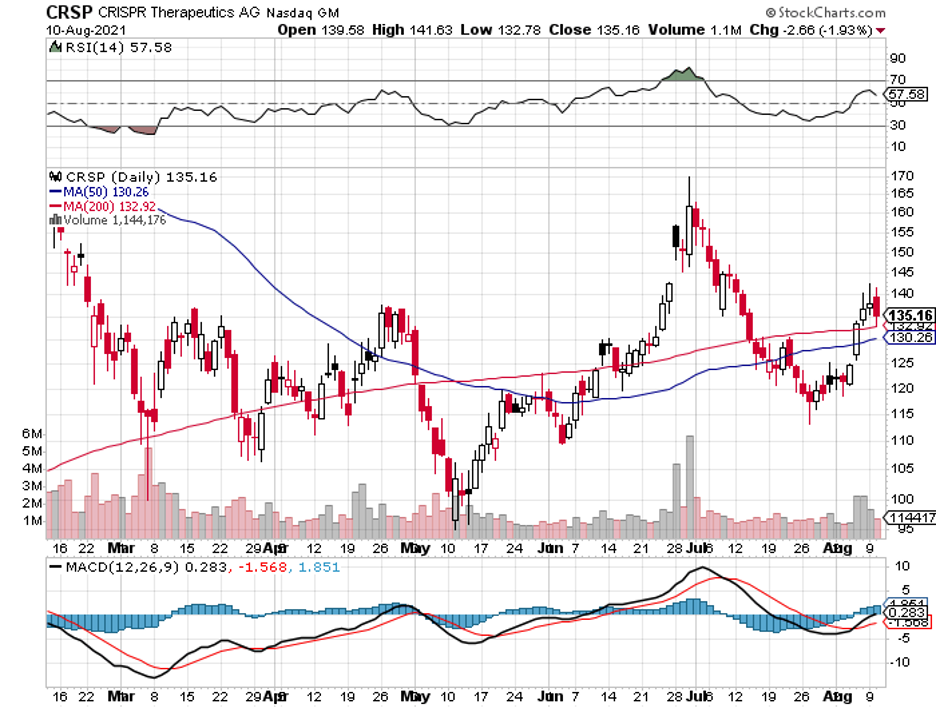
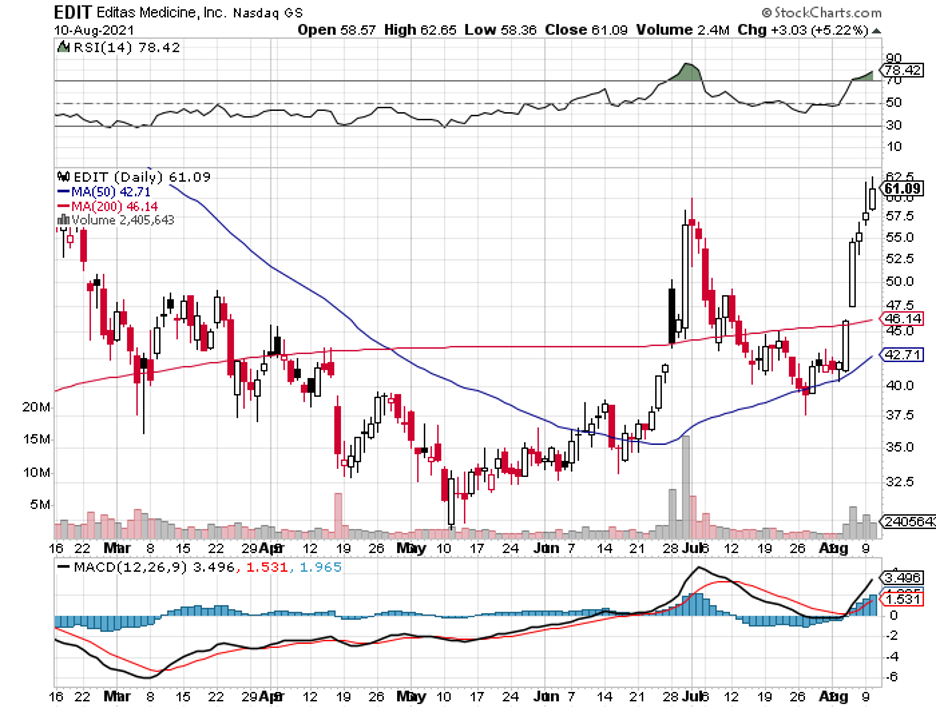
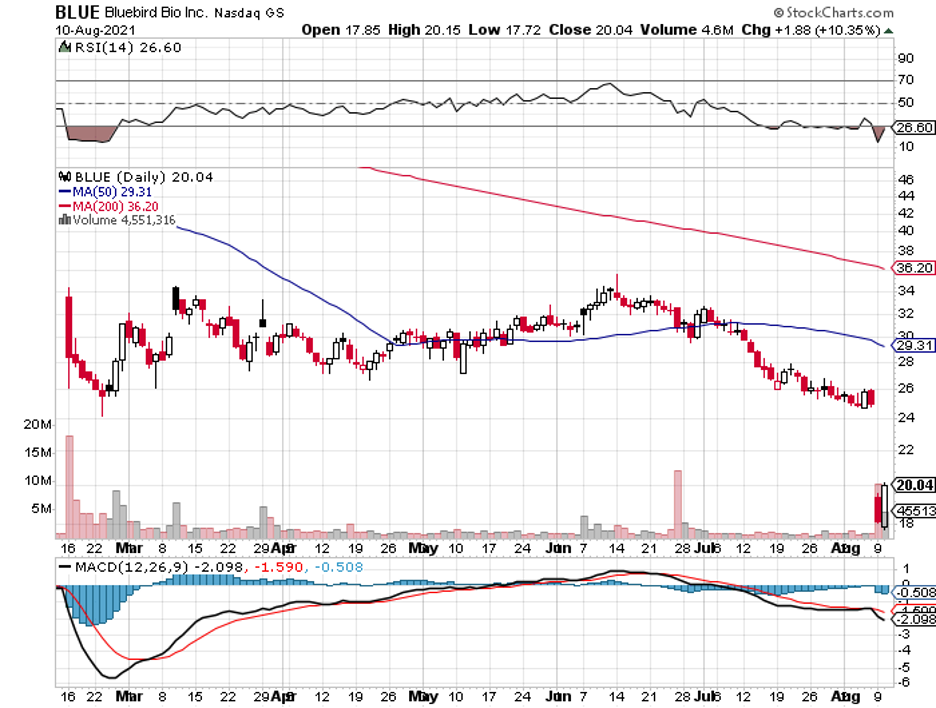
Mad Hedge Biotech & Healthcare Letter
August 5, 2021
Fiat Lux
FEATURED TRADE:
(LET THE BIOTECH BUYOUTS BEGIN)
(TBIO), (SNY), (MRNA), (PFE), (BNTX), (ARCT), (GSK), (JNJ), (MRK), (BLUE), (CVAC)

One of my predictions for this year just came true: the biotechnology buyouts have begun.
In my letter last January, I forecasted that the growing popularity of the mRNA technology courtesy of the COVID-19 vaccines from Moderna (MRNA) and Pfizer (PFE / BioNTech (BNTX) would trigger acquisitions of smaller biotechnology companies this year.
I predicted that bigger players in the healthcare industry would scoop up smaller players to stake a claim in this quickly growing space.
Topping our list of buyout candidates is Translate Bio (TBIO)—the very same company hogging headlines in the past days following its $3.2 billion acquisition by Sanofi (SNY).
The all-cash deal values each TBIO share at $38, representing a premium of over 30% above the stock’s price. If all goes well, the deal should be completed by the third quarter of 2021.
This is one of the first major moves by Sanofi following the healthcare giant’s recent pivot into vaccines.
However, this isn’t the first time Sanofi and TBIO worked together.
The two companies have actually started collaborating back in 2018, working on a potential mRNA-based flu vaccine—a project that has Sanofi and TBIO ahead of the pack, with BioNTech and Arcturus Therapeutics Inc. (ARCT) trailing behind.
Sanofi and TBIO’s mRNA seasonal flu vaccine candidate is expected to commence with Phase 1 results expected to be out by the fourth quarter of this year.
Considering that Sanofi is one of the leading vaccine makers in the world with roughly $3 billion in sales in flu vaccines alone in 2020, it won’t come as a surprise if their candidate breezes through the trials.
Even prior to this acquisition, Translate Bio has been working on using its mRNA platform to develop vaccines and treatments for a broad range of diseases like liver and pulmonary ailments.
So far, its novel pipeline has 2 clinical-stage programs along with 7 pre-clinical work covering direct therapeutics and vaccines.
One of its lead candidates is MRT5005, which is an mRNA-based therapy for cystic fibrosis (CF).
This is a groundbreaking treatment because it takes advantage of mRNA’s capability to deliver proteins to lung cells. It’s also extremely non-invasive, as patients can simply inhale the mRNA drug into their bodies.
Other than helping with the treatment of CF, this inhalation delivery system can also open avenues for other pulmonary targets.
Most importantly, TBIO’s MRT5005 doesn’t only offer treatments. It actually is a cure for CF.
TBIO’s work on CF treatment is extremely important. This disease is terrible, recording a median age of death among patients in the US as 30.6 years old. In this country alone, over 30,000 people suffer from the condition, and more than 70,000 are recorded worldwide—and the numbers continue to climb each year.
In terms of the CF market, the global demand for treatments for this disease is expected to reach $16.3 billion by 2026, hitting roughly 16.8% in CAGR over the years.
With the acquisition of Translate Bio, Sanofi plows ahead of its competitors in the space, including Pfizer, GlaxoSmithKline (GSK), Johnson & Johnson (JNJ), and Merck (MRK), as the sole Big Pharma company with a wholly-owned in-house mRNA platform.
This is on top of Sanofi’s recent $470 buyout of another mRNA company, Tidal Therapeutics, to bolster its immuno-oncology and inflammatory diseases segments.
Apart from its aggressive buyout strategy, Sanofi also announced its plan to allocate roughly $476 million annually to a “vaccines mRNA Center of Excellence” with the goal of queuing at least six mRNA-based candidates in clinical trials by 2025.
Allotting $476 million to this plan is a telling move on the company’s future direction, as it comprises a substantial fraction of Sanofi’s $6.5 billion overall R&D budget.
These moves strongly signal that Sanofi’s going all-in on the mRNA platform, which could obviously pose a challenge to the likes of Moderna and, of course, BioNTech.
With smaller cap companies like bluebird Bio (BLUE) and CureVac (CVAC) still up for grabs, it’s only a matter of time before another big company decides to follow suit.
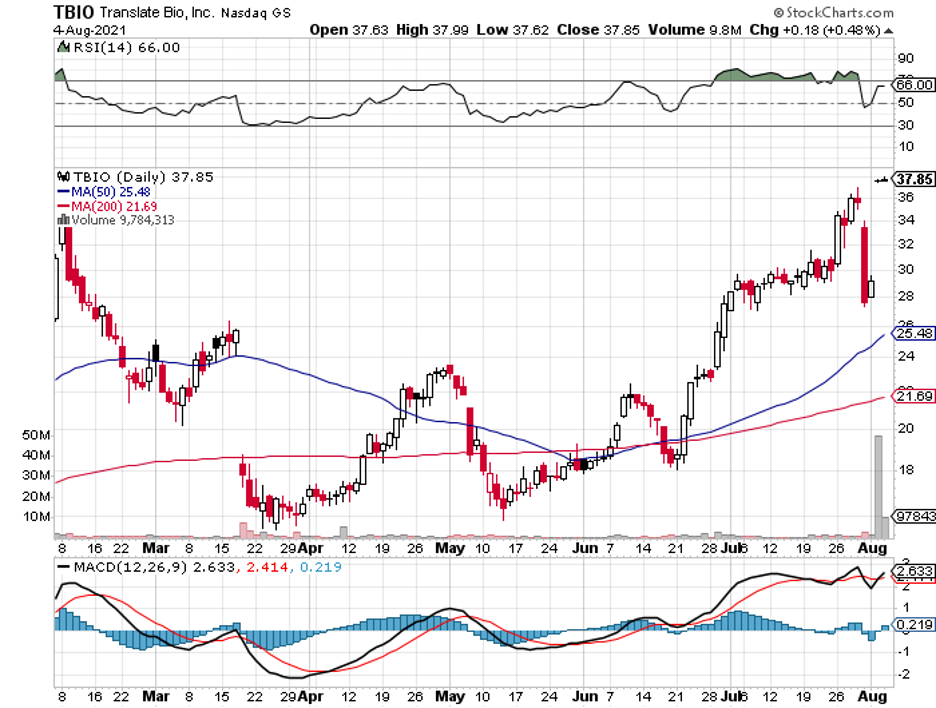
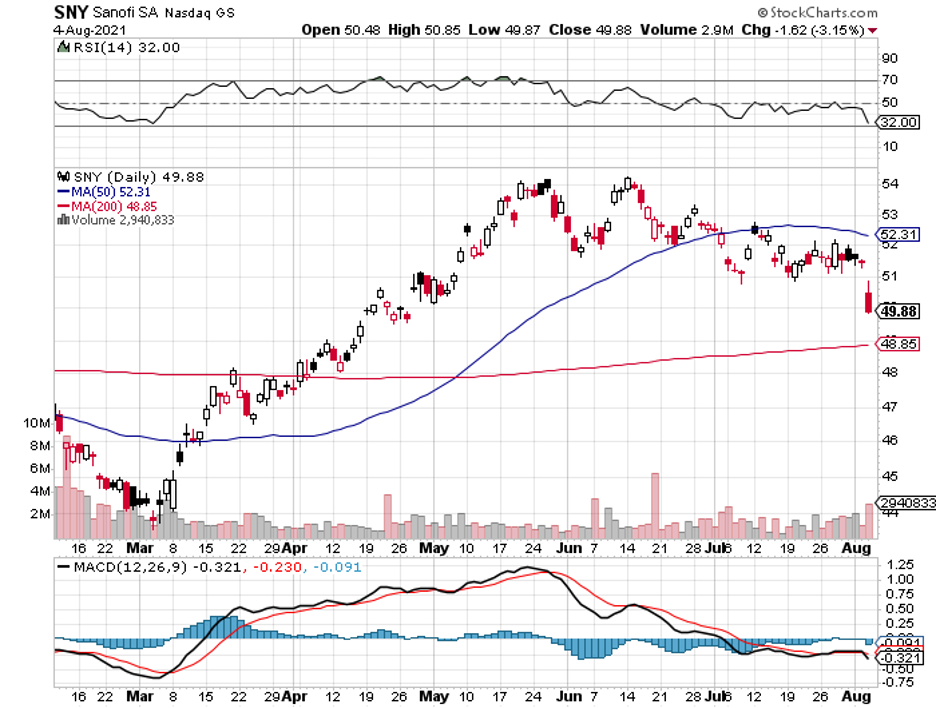
Legal Disclaimer
There is a very high degree of risk involved in trading. Past results are not indicative of future returns. MadHedgeFundTrader.com and all individuals affiliated with this site assume no responsibilities for your trading and investment results. The indicators, strategies, columns, articles and all other features are for educational purposes only and should not be construed as investment advice. Information for futures trading observations are obtained from sources believed to be reliable, but we do not warrant its completeness or accuracy, or warrant any results from the use of the information. Your use of the trading observations is entirely at your own risk and it is your sole responsibility to evaluate the accuracy, completeness and usefulness of the information. You must assess the risk of any trade with your broker and make your own independent decisions regarding any securities mentioned herein. Affiliates of MadHedgeFundTrader.com may have a position or effect transactions in the securities described herein (or options thereon) and/or otherwise employ trading strategies that may be consistent or inconsistent with the provided strategies.
This site uses cookies. By continuing to browse the site, you are agreeing to our use of cookies.
OKLearn moreWe may request cookies to be set on your device. We use cookies to let us know when you visit our websites, how you interact with us, to enrich your user experience, and to customize your relationship with our website.
Click on the different category headings to find out more. You can also change some of your preferences. Note that blocking some types of cookies may impact your experience on our websites and the services we are able to offer.
These cookies are strictly necessary to provide you with services available through our website and to use some of its features.
Because these cookies are strictly necessary to deliver the website, refuseing them will have impact how our site functions. You always can block or delete cookies by changing your browser settings and force blocking all cookies on this website. But this will always prompt you to accept/refuse cookies when revisiting our site.
We fully respect if you want to refuse cookies but to avoid asking you again and again kindly allow us to store a cookie for that. You are free to opt out any time or opt in for other cookies to get a better experience. If you refuse cookies we will remove all set cookies in our domain.
We provide you with a list of stored cookies on your computer in our domain so you can check what we stored. Due to security reasons we are not able to show or modify cookies from other domains. You can check these in your browser security settings.
These cookies collect information that is used either in aggregate form to help us understand how our website is being used or how effective our marketing campaigns are, or to help us customize our website and application for you in order to enhance your experience.
If you do not want that we track your visist to our site you can disable tracking in your browser here:
We also use different external services like Google Webfonts, Google Maps, and external Video providers. Since these providers may collect personal data like your IP address we allow you to block them here. Please be aware that this might heavily reduce the functionality and appearance of our site. Changes will take effect once you reload the page.
Google Webfont Settings:
Google Map Settings:
Vimeo and Youtube video embeds:
